


September in the Champagne vineyards of France, a low sun, the grapes being harvested and plenty of opportunities to taste.
Then the beautiful chateaux of the Loire valley, elegant mansions and massive fortresses and their varied and fascinating histories to explore .


September is a lovely time to visit the vineyards, traditionally harvest time when whole familes spend days in the fields and many workers are hired to help.
In 1992 we stayed at the Manoir de Montflambert 10km north east of Epernay in the small village of Mutigny. The Manoir is a large, seventeenth century manor house with high ceilings and a lovely courtyard. The village itself, with its tiny square-towered, sixteenth century church of St Martin, sits on a ridge surrounded by vineyards.




Our first night we drove into Epernay for a superb dinner at Chez Max - excellent Chateaubriand!
The following day we went into Epernay and discovered it isn't possible to visit the actual wine Chateaux - many of the cellars are actually in the towns. We visited Moët & Chandon in Epernay and had an excellent tour which was free and included a glass of bubbly - we also bought some! The cellars at Moët are very impressive, carved out of the limestone rock they extend below ground to a depth of 30m. The Moët House was founded in 1743 by Claude Moët and has the most extensive vineyards in the chalky soil of the Champagne region.


That afternoon we went into Reims, only 30km north, and visited the Gothic cathedral. It has some beautiful stained glass, including a depiction of wine-making. Afterwards we visited Piper but were very unimpressed with the tour which was conducted in little electric cars with commentary and plastic grapes and figures in the tunnels - 20FF and no free glass! We still bought a bottle which had a 20FF discount.


The Taittinger tour, on the other hand, was completely excellent with the most impressive Gothic cellars in the bare chalk. These date back to the fourth century when they were chalk pits, dug to mine the chalk itself. In the thirteenth century they were part of the cellars of St Nicaise Abbey, joined by a network of tunnels, and used to store the monks' champagne. Fortunately, though the abbey was destroyed during the French Revolution, the cellars survived. Couldn't resist buying more champagne.
We spent quite a bit of time just exploring the vineyards. It was lovely autumn weather, warm and sunny, and the vineyards looked gorgeous.



We met an extended family harvesting beautiful grapes from their vines. They were very friendly and we chatted a while with them, though the work never ceased. They said that harvesting had started the previous Monday, 100 days after the vines had flowered.

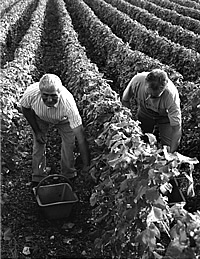
While some picked - back-breaking work - others sorted and packed the grapes.
Three varieties of grape go into a classic champagne: white Chardonnay and black Pinot Noir and Pinot Meunier.



The owner of the vines, Gilbert, was a very nice man. I hope none of the pickers mind me putting their images on the Internet after all these years - I hope they'll get in touch if they do! Though it it would be nice to hear from them again even if they don't mind! email

Roses are very often planted at the ends of rows of vines. They look lovely but also have a practical purpose, serving as early warnings of diseases such as mildew which both plants suffer from.
At the time we were here there was to be a referendum on the Maastricht Treaty and there were quite a few political posters around, those of the far right Front National party urging a "No" vote. The treaty was ratified by an extremely narrow margin.

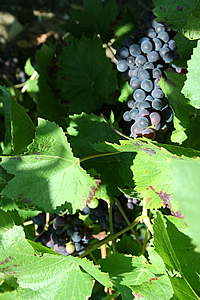


In 2008 we returned briefly to the Champagne region, again in a beautiful September.

We were specifically looking for Delahaie, one of the smaller producers but one of our favourites. We didn't find it (later discovered we needed to go into Epernay) but did taste and buy some excellent champagne at Mailly, a very modern establishment set among the vines near Mailly village.

Mailly is a Champagne House which creates only Grand Cru wines i.e. those made from grapes from one of the few designated Grand Cru villages - Grand Cru is the highest classification for champagne. Only 17 out of over 300 villages hold Grand Cru status, all in Marne.
We stopped off in the village of Sacy to visit the eleventh century Romanesque church of Saint Rémi.
It is a very simple building, with typical round-arched windows - some in the tower had been crudely blocked up.
There are quite a lot of ancient churches in this area, many of them fortified, their towers used as lookouts. From the tower of St Rémi there would certainly have been a good view over the surrounding landscape which is quite flat - all the better for working the vines which cover every available square metre of ground.


In 1992 we travelled on from the Champagne region to the Loire for more wine-tasting and chateau exploration. We stayed in a gîte in the middle of the countryside - it ws OK after a dodgy start when we arrived to find it locked. Failing to raise the owner or agent we had to take a room at the Hotel du Lion D'Or in Noyant, a rather basic place but OK for one night. The following morning we managed to contact the mother of the owner who let us in. We have never again considered staying in a gîte!

Our first day in the region we went into Saumur for an excellent lunch and walked up to the chateau. This enormous thirteenth century fortress stands high above the Loire River and is quintissentially French. It houses a museum and we didn't go in. It was a very overcast day so not great for photographs either.

We continued on a roundabout route to Ackerman's in St. Hilaire and tasted and bought three Brut Royal and three Rosé Brut. This 200 year old House uses traditional methods, including those used to make champagne, to create its sparkling wines. This area is riddled with tunnels and caves dug out of the soft limestone, ideal for storing wine.

It seemed we had left the lovely autumn weather behind in the Champagne for we woke the next day to great crashing thunderstorms! After it calmed down we dodged showers to visit the Chateau of Chinon. Again set above a river, this time the Vienne, the vast fortress of Chinon is quite different to Saumur, looking much more military. It was, in fact, three forts separated by moats and enclosed by a massive wall. The site has been important for defensive purposes for thousands of years and there has been a castle here since at least the tenth century, but it was the English King (and Count of Anjou) Henry II who developed it extensively and it become his favourite home. He died here in 1189.
It's rather a ruin but an impressive one, especially the walls, and the siege engines in the moats are pretty good.

Azay-le-Rideau is different again, a more compact, elegant chateau with little of harsh military design. Begun in the early sixteenth century by a rich financier Gilles Berthelot, the Renaissance chateau remained unfinished when he died. The chateau was in a poor state when the Biencourt family purchased it at the end of the eighteenth century. The family undertook extensive restorations which completed the beautiful building we see today.

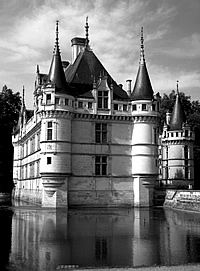

Lying in a loop of the Indre River its stone walls rise straight out of a still expanse of water creating a beautiful, tranquil scene. Inside are tapestries, paintings and antique furniture - huge beds! - but it is the exterior which leaves a lasting impression.


On our travels we stopped in at the Savennières petrified caves but were completely unimpressed. These two limestone caves have been known since Roman times. As a tourism exercise items are placed in the springs running through them and become covered in deposited limestone - totally uninteresting.


The following day we went to the Louresse-Rochemenier troglodyte village and, though quite interesting, we decided these were definitely the last caves we would be entering except for those devoted to fine wine! There is nothing prehistoric or natural about these caves. They were dug by local people, first excavating a deep pit which became the village square, then cutting caves in the walls to create a small settlement. Some were still in use as homes in the 1930s. All around this area caves can be seen cut into the cliff faces but these were the only ones we saw set into the floor of a plain.

On a rainy afternoon we visited the Cointreau distillery in Angers and had an excellent tour - a good tip for Cointreau is to have it chilled as an aperitif! We bought a passion fruit drink - later regretted - and chocolates - not regretted at all!
Back to the chateaux and a fine one at Blois with lots of interest: painted walls and ceilings, a murdered duke, secret panels and a lovely spiral staircase. One other notable claim to fame: it was at Blois in 1429 that Joan of Arc came to be blessed before fighting the English at Orleans.
Parts of the chateau date from the thirteenth century but the main building was constructed by Louis XII at the end of the fifteenth century. Fifteen years later Francois I had a new wing built incorporating a beautiful octagonal spiral staircase. Three sides of the octagon are contained within the building , open to the tall space of the hall so that all that was happening there could be viewed from the balconies.



On the first floor is the room of Catherine de Medici which has panelled walls concealing secret cupboards, said to have contained her poisons! They are opened by pressing a pedal concealed in the skirting board. Catherine was married to Francois' son, Henri II. Catherine died here in 1589.
On to the second floor where Henri, Duc de Guise, was murdered in 1588. As head of the Catholic League he was in direct conflict with the king, Henri III, who organised his assassination. Apparently the king hid behind a tapestry while his men stabbed the duke to death.

From Blois we went on to Chambord, a truly magnificent chateau and the biggest in the Loire. It was built by Francois I who may even have used plans made by Leonardo da Vinci as a basis for the design - Leonardo was a friend of the king and was actually visiting him at the small chateau of Clos-Lucé when he died.


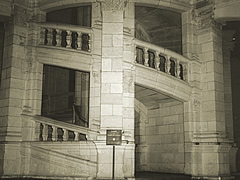


The chateau took around twenty years for the major part of the work to be completed but was still unfinished at the time of Francois' death in 1547 - additional work continued for many years. It's most celebrated feature is an impressive double spiral staircase.
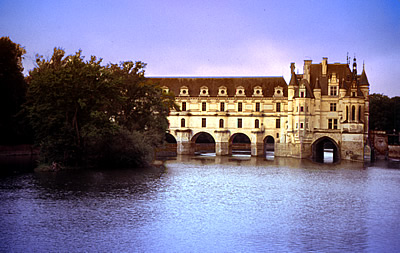
Chenonceau is another attractive sixteenth century chateau built on water, this time across the river Cher. Henri II gave the chateau to his mistress Diane de Poitiers and it was she who had the bridge built linking the castle to the north bank of the river.
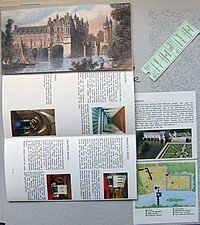

Not as grandiose as Chambord it is nevertheless a very striking building in its peaceful rural setting.
When Henri died his widow Catherine de Medici took her revenge on the hapless Diane and seized the chateau, forcing Diane to leave, though she was allowed the Chateau de Chaumont.


We went to several other less well-known chateaux: Amboise, the childhood home of Francois I, with some attractive stone carving, pretty white-walled Ussé which we did not go into, and Langeais surrounded by houses but with a very impressive entrance complete with drawbridge.


Our final stop was Villandry, celebrated not so much for the buildings as for its extensive formal gardens. The chateau itself is of pure Renaissance design, completed in 1536, and one of the last great Loire chateaux to be built. The gardens are equally pure Italian Renaissance in style, laid out in three sections: the water garden is at the highest level, next the flower garden and finally the kitchen garden.
The flower garden is composed of geometrical plots outlined in box, one as an allegory of love, others as a Maltese Cross and Fleur de Lys. The kitchen garden consists of nine squares of colourful vegetables. Not my kind of garden really, but very fitting for the location.

And the Loire wine - well we weren't terrifically impressed, though we did buy some sparkling red at Gratien & Meyer - very unusual!

